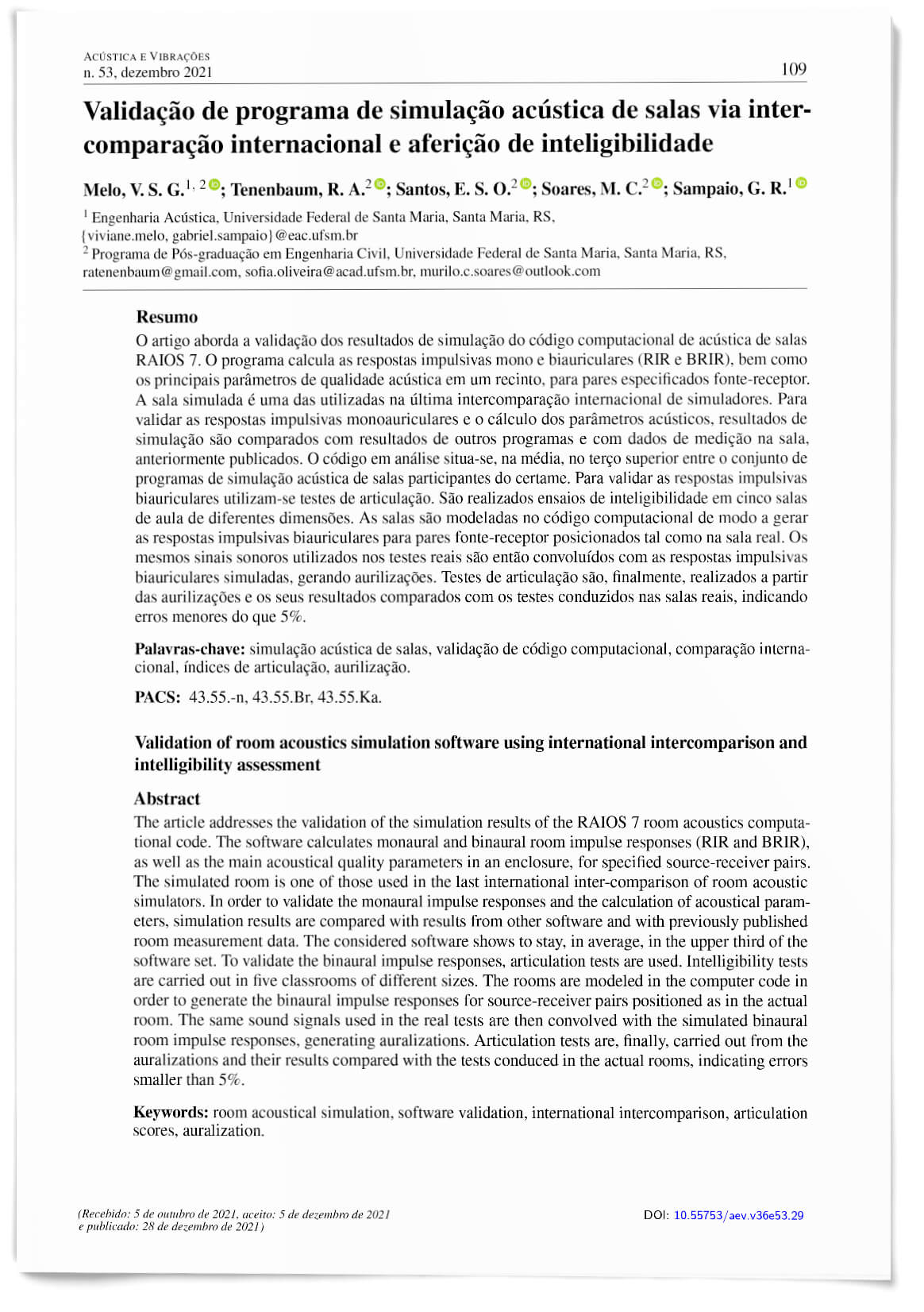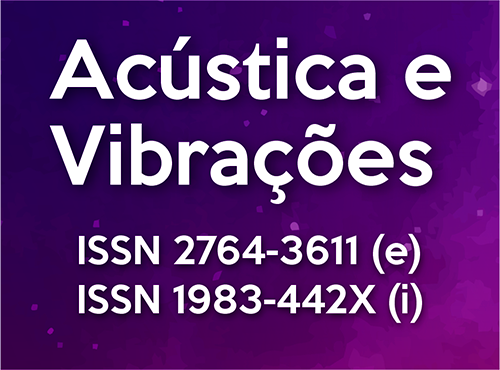Validação de programa de simulação acústica de salas via intercomparação internacional e aferição de inteligibilidade
DOI:
https://doi.org/10.55753/aev.v36e53.29Palavras-chave:
simulação acústica de salas, validação, comparação internacional, índices de articulação, aurilizaçãoResumo
Este artigo aborda a validação dos resultados de simulação do código computacional de acústica de salas do Software RAIOS 7. O programa calcula as respostas impulsivas mono e biauriculares (RIR e BRIR), bem como os parâmetros de qualidade acústica em um dado recinto, para pares especificados fonte-receptor. De modo a validar as respostas impulsivas monoauriculares e o cálculo dos parâmetros acústicos, resultados de simulação são comparados com resultados de outros programas, bem como com dados de medição na sala, anteriormente publicados. A sala simulada é uma das utilizadas na última intercomparação internacional de simuladores. Mostra-se que o código computacional em estudo apresentou desvios similares aos demais programas. Para validar as respostas impulsivas biauriculares utilizam-se testes de articulação. São realizados ensaios de inteligibilidade em cinco salas de aula de diferentes dimensões. As mesmas salas são modeladas no código computacional de modo a gerar as respostas impulsivas biauriculares para pares fonte-receptor posicionados tal como na sala real. Os mesmos sinais sonoros utilizados nos testes reais são então convoluídos com as respostas impulsivas biauriculares simuladas, gerando aurilizações. Testes de articulação são, finalmente, realizados e os seus resultados comparados com os testes conduzidos nas salas reais, indicando erros menores que 5%.
Referências
ALLRED, John C.; NEWHOUSE, Albert. Applications of monte carlo method to architectural acoustics. The Journal of the Acoustical Society of America, v. 30, n. 1, p. 1–3, 1958 ISSN 0001-4966. doi: 10.1121/1.1909368. DOI: https://doi.org/10.1121/1.1909368
SCHROEDER, Manfredr R.; ATAL, Bishnu S.; BIRD, C. Digital computers in room acoustics. In: Proceedings of the 4th International Congress on Acoustics. Copenhagen, Dinamarca: [s.n.], 1962. p. M21.1–M21.4. Disponível em: https://soundandscience.de/node/569.
AHNERT, Wolfgang; FEISTEL, Rainer. Binaural auralization from a sound system simulation programme. In: AES 91st Convention. New York, NY, EUA: [s.n.], 1991. Disponível em:http://www.aes.org/e-lib/browse.cfm?elib=5589.
BLAUERT, Jens; LEHNERT, Hilmar; POMPETZKI, W.; XIANG, Ning. Binaural room simulation. Acustica, v. 72, p. 295–296, 1990.
LEHNERT, Hilmar; BLAUERT, Jens. Principles of binaural room simulation. Applied Acoustics, v. 36, n. 3, p. 259–291, 1992. ISSN 0003-682X. doi: 10.1016/0003-682X(92)90049-X. DOI: https://doi.org/10.1016/0003-682X(92)90049-X
KLEINER, Mendel; DALENBÄCK, BengtInge; SVENSSON, Peter. Auralization – an overview. Journal of The Audio Engineering Society, v. 41, p. 861–875, 1993. Disponível em: http://www.aes.org/e-lib/browse.cfm?elib=6976.
BEGAULT, Durand R. 3-D sound for virtual reality and multimedia. Cambridge: Academic Press Professional, 1994. ISBN 978-0120847358.
DALENBACK, Bengt-Inge; MCGRATH David. Narrowing the gap between virtual reality and auralization. In: Proceedings of the 15th International Congress on Acoustics. Trondheim, Noruega: [s.n.], 1995. v. 2, p. 429–432. Disponível em: https://www.icacommission.org/Proceedings/ICA1995Trondheim/ICA15%20Proceedings%20Vol2.pdf.
SOTTEK, Roland. Virtual binaural auralization of product sound quality: Importance and application in practice. In: Proceedings of the 5th European Conference Noise Control – EURONOISE. Naples, Italy: [s.n.], 2003. Disponível em: https://global.head-acoustics.com/downloads/publications/sound_quality/Euronoise2003_Virtual_Binaural_Auralisation.pdf.
TORRES, Julio C. B.; PETRAGLIA, Mariane R.; TENENBAUM, Roberto A. An efficient wavelet-based HRTF for auralization. Acta Acustica united with Acustica, v. 90, n. 1, p. 108–120(13), 2004. ISSN 1610-1928. Disponível em: https://www.ingentaconnect.com/contentone/dav/aaua/2004/00000090/00000001/art00014.
OTONDO, Felipe; RINDEL, Jens H. A new method for the radiation representation of musical instruments in auralizations. Acta Acustica united with Acustica, v. 91, n. 5, p. 902–906(5), 2005. ISSN 1610-1928. Disponível em: https://www.ingentaconnect.com/content/dav/aaua/2005/00000091/00000005/art00011.
DALENBÄCK, Bengt-Inge; STROMBERG, M. Real time walkthrough auralization – the first year. In: 1st IOA Annual Conference. Copenhagen, Denmark: [s.n.], 2006. v. 28 (2). Disponível em: http://www.catt.se/Walker-IOA-Copenhagen-2006.pdf. DOI: https://doi.org/10.1080/01919510600648295
SUMMERS, Jason E. ‘What exactly is meant by the term ‘auralization?’. The Journal of the Acoustical Society of America, v. 124, n. 2, p. 697–697, 2008. ISSN 0001-4966. doi: 10.1121/1.2945708. DOI: https://doi.org/10.1121/1.2945708
VORLÄNDER, Michael. International round robin on room acoustical computer simulation. In: Proceedings of the 15th International Congress on Acoustics. Trondheim, Norway: [s.n.], 1995. p. 689–692.
BORK, Ingolf. A comparison of room simulation software – the 2nd round robin on room acoustical computer simulation. Acta Acustica united with Acustica, v. 86, n. 6, p. 943–956(14), 2000. ISSN 1610-1928. Disponível em: https://www.ingentaconnect.com/contentone/dav/aaua/2000/00000086/00000006/art00008.
BORK, Ingolf. Report on the 3rd round robin on room acoustical computer simulations — Part I: Measurements. Acta Acustica united with Acustica, v. 91, n. 4, p. 740–752(13), 2005. ISSN 1610-1928. Disponível em: https://www.ingentaconnect.com/contentone/dav/aaua/2005/00000091/00000004/art00015.
BORK, Ingolf. Report on the 3rd round robin on room acoustical computer simulations – Part II: Calculations. Acta Acustica united with Acustica, v. 91, n. 4, p. 753–763(11), 2005. ISSN 1610-1928. Disponível em: https://www.ingentaconnect.com/contentone/dav/aaua/2005/00000091/00000004/art00016.
BRINKMANN, Fabian; ASPÖCK, Lukas; ACKERMANN, David; LEPA, Steffen; VORLÄNDER, Michael; WEINZIERL, Stefan. A round robin on room acoustical simulation and auralization. The Journal of the Acoustical Society of America, v. 145, n. 4, p.2746–2760, 2019. ISSN 0001-4966. doi: 10.1121/1.5096178. DOI: https://doi.org/10.1121/1.5096178
KUTTRUFF, Heinrich. Room Acoustics. 5. ed. Madison Avenue, New York, USA: Spon Press, 2009. ISBN 978-0-07-160333-1.
SAVIOJA, Lauri; SVENSSON, U. Peter. Overview of geometrical room acoustic modeling techniques. The Journal of the Acoustical Society of America, v. 138, n. 2, p. 708–730, 2015. ISSN 0001-4966. doi: 10.1121/1.4926438. Disponível em: https://asa.scitation.org/doi/pdf/10.1121/1.4926438. DOI: https://doi.org/10.1121/1.4926438
KROKSTAD, Asbjörn; STROM, S.; SORSDAL, Svein. Calculating the acoustical room response by the use of ray tracing technique. Journal of Sound and Vibration, v. 8, n. 1, p. 118–125, 1968. ISSN 0022-460X. doi: 10.1016/0022-460X(68)90198-3. DOI: https://doi.org/10.1016/0022-460X(68)90198-3
FARINA, Angelo. Pyramid tracing vs ray tracing for the simulation of sound propagation in large rooms. WIT Transactions on the Built Environment, v. 10, p. 109–116, 1995. ISSN 1743-3509. Disponível em: https://www.witpress.com/elibrary/wit-transactions-on-the-built-environment/11/10132.
BORISH, Jeffrey. Extension of the image model to arbitrary polyhedra. The Journal of the Acoustical Society of America, v. 75, p. 1827–1836, 1984. ISSN 0001-4966. doi: 10.1121/1.390983. DOI: https://doi.org/10.1121/1.390983
VORLÄNDER, Michael. Simulation of the transient and steady-state sound propagation in rooms using a new combined ray-tracing/image-source algorithm. The Journal of the Acoustical Society of America, v. 86, n. 1, p. 172–178, 1989. ISSN 0001-4966. doi: 10.1121/1.398336. DOI: https://doi.org/10.1121/1.398336
DALENBÄCK, Bengt-Inge; KLEINER, Mendel; SVENSSON, Peter. A macroscopic view of the diffuse reflection. Journal of The Audio Engineering Society, v. 42, n. 10, p. 973–987, 1994. Disponível em: https://www.aes.org/e-lib/browse.cfm?elib=6927.
COX, Trevor J.; DALENBÄCK, Bengt-Inge; D’ANTONIO, Peter; EMBRECHTS, Jean J.; JEON, Jin Y.; MOMMERTZ, Eckard; VORLÄNDER, Michael. A tutorial on scattering and diffusion coefficients for room acoustic surfaces. Acta Acustica united with Acustica, v. 92, n. 1, p. 1–15(15), 2006. ISSN 1610-1928. Disponível em: https://www.ingentaconnect.com/contentone/dav/aaua/2006/00000092/00000001/art00002.
ALARCÃO, Diogo; BENTO-COELHO, José L. TENENBAUM, Roberto A. On modeling of room acoustics by a sound energy transition approach. In: EEA Symposium on Architectural Acoustics. Madrid, Spain: [s.n.], 2000.
BALLESTEROS, Marcos L. Simulação numérica de acústica de salas. (Dissertação de Mestrado) — Universidade Federal do Rio de Janeiro - PEM/COPPE/UFRJ, Rio de Janeiro, RJ, 1991. Disponível em: https://w1files.solucaoatrio.net.br/atrio/ufrj-pem_upl//THESIS/1660/pemufrj1991mscmarcosdelimaballesteros_20150825122313512pdf.
PINTO, Fábio A. V. Audição biauricular: um protótipo. (Dissertação de Mestrado) — Universidade Federal do Rio de Janeiro - PEP/COPPE/UFRJ, Rio de Janeiro, RJ, 2001.
CAMILO, Thiago S. B. Método híbrido para simulação de acústica de salas: combinação dos métodos de traçado de raios e transição de energia. (Dissertação de Mestrado) — Universidade Federal do Rio de Janeiro - PEM/-COPPE/UFRJ, Rio de Janeiro, RJ, 2003.
NARANJO, José F. L. Aperfeiçoamentos no código computacional RAIOS incluindo aurilização. (Dissertação de Mestrado) — Universidade do Estado do Rio de Janeiro - PPGMC/IPRJ/UERJ, Nova Friburgo, RJ, 2010. Disponível em: https://www.bdtd.uerj.br:8443/handle/1/13844.
TORRES, Júlio C. B. Sistema de auralização eficiente utilizando transformadas wavelet. Tese (Doutorado) — Universidade Federal do Rio de Janeiro - PEE/COPPE/UFRJ, Rio de Janeiro, RJ, 2004. Disponível em: http://www.pee.ufrj.br/index.php/pt/producao-academica/teses-de-doutorado/2004/2004037002-2004037002/file.
NARANJO, José F. L. Inteligência computacional aplicada na geração de respostas impulsivas biauriculares e em aurilização de salas. Tese (Doutorado) — Universidade do Estado do Rio de Janeiro - PPGMC/IPRJ/UERJ, Nova Friburgo, RJ, 2014. Disponível em: http://www.bdtd.uerj.br/handle/1/13684.
TAMINATO, Filipe O. Redes neurais artificiais aplicadas à modelagem de HRIRs/HRTFs para gerar aurilização. Tese (Doutorado) — Universidade do Estado do Rio de Janeiro - PPGMC/IPRJ/UERJ, Nova Friburgo, RJ, 2018. Disponível em: https://www.bdtd.uerj.br:8443/handle/1/13714.
HAYKIN, Simon. Neural Networks and Learning Machines. 3. ed. New Jersey: Prentice Hall, 2009. ISBN -13:978-0-13-147139-9.36. TENENBAUM, Roberto A.; TAMINATO, Filipe O.; MELO, Viviane S.G. Fast auralization using radial basis functions type of artificial neural network techniques. Applied Acoustics, v. 157, p. 106993, 2020. ISSN 0003-682X. doi:10.1016/j.apacoust.2019.07.041. DOI: https://doi.org/10.1016/j.apacoust.2019.07.041
TENENBAUM, Roberto A.; CAMILO, Thiago S.; B., Julio C.; TORRES; GERGES, Samir N. Y. Hybrid method for numerical simulation of room acoustics with auralization: Part 1 - theoretical and numerical aspects. Journal of the Brazilian Society of Mechanical Sciences and Engineering, v. 29, n. 2, p. 211–221, jun. 2007. ISSN 1678-5878. doi: 10.1590/S1678-58782007000200012. DOI: https://doi.org/10.1590/S1678-58782007000200012
TENENBAUM, Roberto A.; CAMILO, Thiago S.; TORRES, Julio C. B.; STUTZ, Leonardo T. Hybrid method for numerical simulation of room acoustics: Part 2 – validation of the computational code RAIOS 3. Journal of the Brazilian Society of Mechanical Sciences and Engineering, v. 29, n. 2, p. 211–221, 2007. ISSN 1678-5878. doi: 10.1590/S1678-58782007000200013. DOI: https://doi.org/10.1590/S1678-58782007000200013
INTERNATIONAL STANDARDS ORGANIZATION. ISO 3382: Acoustics – Measurement of room acoustic parameters – Part 1: Performance spaces. Geneva, 2009. Disponível em: https://www.iso.org/standard/40979.html.
INTERNATIONAL STANDARDS ORGANIZATION. ISO 3382: Acoustics – Measurement of room acoustic parameters – Part 2: Reverberation time in ordinary rooms. Geneva, 2008. Disponível em: https://www.iso.org/standard/36201.html.
INTERNATIONAL STANDARDS ORGANIZATION. ISO 3382: Acoustics – Measurement of room acoustic parameters – Part 3: Open plan offices. Geneva, 2012. Disponível em: https://www.iso.org/standard/46520.html.
TENENBAUM, Roberto A.; TAMINATO, Filipe O.; MELO, Viviane S. G.; TORRES, Julio C. B. Auralization generated by modeling HRIRs with artificial neural networks and its validation using articulation tests. Applied Acoustics, v. 130, p. 260–269, 2018. ISSN 0003-682X. doi: 10.1016/j.apacoust.2017.09.025. DOI: https://doi.org/10.1016/j.apacoust.2017.09.025
ASPÖCK, Lukas; BRINKMANN, Fabian; ACKERMANN, David; WEINZIERL, Stefan; VORLÄNDER, Michael. (Repositório), GRAS – Ground Truth for Room Acoustical Simulation. 2018. doi: 10.14279/depositonce-6726.
LINDAU, Alexander; ERBES, Vera; LEPA, Steffen; MAEMPEL, Hans-Joachim; BRINKMAN, Fabian; WEINZIERL, Stefan. A spatial audio quality inventory for virtual acoustic environments (SAQI). Acta Acustica united with Acustica, v. 100, n. 5,p.984–994(11), 2014. ISSN 1610-1928. doi: https://doi.org/10.3813/AAA.918778. DOI: https://doi.org/10.3813/AAA.918778
PENG, Jianxin. Feasibility of subjective speech intelligibility assessment based on auralization. Applied Acoustics, v. 66, n. 5, p.591–601, 2005. ISSN 0003-682X. doi: 10.1016/j.apacoust.2004.08.006. DOI: https://doi.org/10.1016/j.apacoust.2004.08.006
YANG, Wonyoung; HODGSON, Murray. Validation of the auralization technique: Comparative speech intelligibility tests in real and virtual classrooms. Acta Acustica united with Acustica, v. 93, n. 6, p. 991–999(9), 2007. ISSN 1610-1928. Disponível em: https://www.ingentaconnect.com/contentone/dav/aaua/2007/00000093/00000006/art00013.
HODGSON, Murray; YORK, Natalie; YANG, Wonyoung; BLISS, Mark. Comparison of predicted, measured and auralized sound fields with respect to speech intelligibility in classrooms using catt-acoustic and odeon. Acta Acustica united with Acustica, v. 94, n.6, p. 883–890(8), 2008. ISSN 1610-1928. doi: https://doi.org/10.3813/AAA.918106. DOI: https://doi.org/10.3813/AAA.918106
MELO, Viviane S. G.; TENENBAUM, Roberto A.; MUSAFIR, Ricardo E. Intelligibility assessment in elementary school classrooms from binaural room impulse responses measured with a childlike dummy head. Applied Acoustics, v. 74, p. 1436–1447, 2013. ISSN 0003-682X. doi: https://doi.org/10.1016/j.apacoust.2013.06.005. DOI: https://doi.org/10.1016/j.apacoust.2013.06.005
MELO, Viviane S. G.; TENENBAUM, Roberto A.; NARANJO, José F. L. A new approach to validate computer modeling auralizations by using articulation indexes. Acústica e Vibrações, v. 46, p. 1–8, 2014. ISSN 2764-3611, 1983-442X.
TENENBAUM, Roberto A.; TAMINATO, Filipe O.; MELO, Viviane S. G. Validating auralizations by using articulation indexes. In: Proceedings of Meetings on Acoustics (POMA) of the 22nd International Congress on Acoustics. Buenos Aires, Argentina: [s.n.], 2016. doi: https://doi.org/10.1121/2.0000318. DOI: https://doi.org/10.1121/2.0000318
ALCAIM, Abraham; SOLEWICZ, Jose A.; MORAES, Joao A. Frequência de ocorrência dos fones e listas de frases foneticamente balanceadas no português falado no Rio de Janeiro. Revista da Sociedade Brasileira de Telecomunicações, v. 7, n. 1, p. 23–41, 1992. Disponível em: https://jcis.sbrt.org.br/jcis/article/download/166/80. DOI: https://doi.org/10.14209/jcis.1992.2
MELO, Viviane S. G. Avaliação de inteligibilidade em salas de aula do ensino fundamental a partir de respostas impulsivas biauriculares obtidas com cabeça artificial de dimensões infantis. Tese (Doutorado) — Universidade Federal do Rio de Janeiro - PEM/COPPE/UFRJ, Rio de Janeiro, RJ, 2012. Disponível em: https://w1files.solucaoatrio.net.br/atrio/ufrj-pem_upl//THESIS/3/pemufrj2012dscvivianesuzeygomesdemelo.pdf.
TAMINATO, Filipe O.; TENENBAUM, Roberto A.; MELO, Viviane S. G. Técnica rápida para geração de aurilizações utilizando redes neurais artificiais. Acústica e Vibrações, v. 50, p. 25–38, 2018. ISSN 2764-3611, 1983-442X.
MÜLLER-TRAPETA, Markus; VORLÄNDER, Michael. Uncertainty analysis of standardized measurements of random-incidence absorption and scattering coefficients. The Journal of the Acoustical Society of America, v. 137, n. 1, p. 63, 2015. ISSN 0001-4966. doi: 10.1121/1.4904512. DOI: https://doi.org/10.1121/1.4904512

Downloads
Publicado
Como Citar
Edição
Seção
Licença
Copyright (c) 2021 Acústica e Vibrações

Este trabalho está licenciado sob uma licença Creative Commons Attribution-NonCommercial-ShareAlike 4.0 International License.




